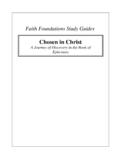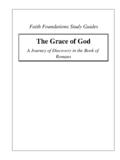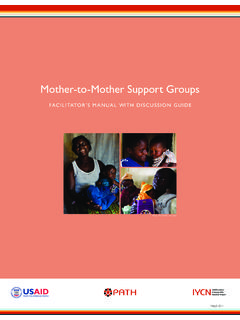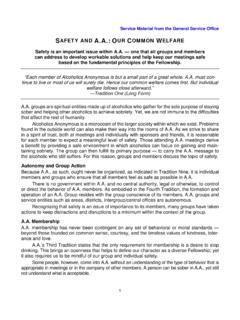Transcription of Faith Foundations Study Guides
1 Faith Foundations Study Guides An Undivided Heart for God A Journey of Discovery in the Book of James Alan Perkins 2010 All rights reserved. Printed in Unless otherwise noted, Scripture quotations in this publication are from the HOLY BIBLE, NEW INTERNATIONAL VERSION . NIV Copyright 1973, 1978, 1984 by International Bible Society. Used by permission. All rights reserved. How to Use This BookWelcome to the Faith Foundations Study guide on James! Whether you are just beginning your new life with Christ, or have been a Christian for many years, this Study guide is for you. It is designed to help you discover, through personal Study and group discussion, the incredible riches of God s Word, and to help you grow in your walk with God by applying what you learn. This book is divided into 10 lessons, each of which contains the full NIV text of the Scripture passage, several Study and discussion questions, and a verse-by-verse commentary.
2 So, together with a Bible to look up cross-references, you have everything you need for your "journey of discovery" in James. Why Small Groups? These materials can be used profitably in personal Study or in an adult Sunday School class. But their value will be best realized when they are used in small groups, meeting either at church during the Sunday School hour or in homes during the week. There are several reasons for this. First, no one has perfect insight into every passage of Scripture; we can all benefit from hearing the perspectives of other believers as we seek to understand and apply the Bible. A small group gathering, using the discussion questions included in this book, is an ideal way to stimulate a sharing of observations and ideas. Second, a small group provides a community of fellow travelers who, along with us, are seeking to follow Christ in the midst of family responsibilities, job pressures, and personal struggles. In today s fragmented and mobile society, the natural networks of neighborhoods and family no longer provide the support they once did.
3 We need some way of making connections with others for mutual support, people with whom we can share our joys and sorrows people who will listen, who will pray with us, who will offer a helping hand and a word of encouragement, and who will confront us in love when we ve gotten off track. Finally, a small group combines the benefits of Biblical insight and community support by keeping us accountable. If we only Study the Scriptures alone, or listen to them taught in a large group, it s easy to let them go "in one ear and out the other". But when a small group of people are learning the same things at the same time, they can help one another to apply the things they are learning. How Are the Groups Organized? The groups should be composed of 6-14 people: if they are smaller, any absences can make it difficult to maintain the discussion; if they are larger, not everyone can participate. You can meet from two to four times a month; if the group meets less than twice a month, the members aren t spending enough time together to build relationships.
4 Some groups find that meeting three times a month during the school year, with a break during the summer, provides a good rhythm of involvement and time off. You may choose to include a mix of married and single, older and younger members, or you may organize your groups by age or marital status. There are benefits to homogeneous groups in which the members are going through similar life experiences, but there are also benefits of a diverse group in which the younger members can benefit from the experience of the older. Each group needs to have a recognized leader, preferably one selected and trained by the pastor or church leadership. This person s role during the meeting is not primarily to teach (although preparation of the lesson is a must), but to guide the discussion and keep the group from getting bogged down on side issues. He or she does not need to be the host; in fact, it is preferable that group responsibilities, such as providing a home in which to meet and organizing refreshments, be shared among the members.
5 Finally, membership in the group should be based on three commitments: To prepare for each meeting by completing the lesson in advance, which takes from 1/2 to 2 hours (but come to the meeting even if you haven t done the lesson); to place a high priority on regular attendance and come to the meetings except in case of emergency; and to keep confidential anything of a personal nature which is shared during the meetings (except when it is necessary to communicate concerns to the pastor). What Is the Group Meeting Like? Each group meeting should last from 1 1/2 to 2 hours, and provide time for discussion of the lesson, prayer, and fellowship. A problem in many groups is for the lesson to take up most of the time, with only a few minutes left over for prayer and fellowship. This must be avoided for the goal of building relationships to be achieved. Here is a suggested schedule: 15 minutes: Gathering 30-45 minutes: Discussion of the lesson 20-30 minutes: Prayer 15-30 minutes: Refreshments As for child care, experience has shown that in order to receive the maximum benefit from time spent in the meeting, all members of the group need to be free to focus on the discussion, rather than caring for children.
6 Therefore, with the possible exception of infants under one year, parents should make arrangements for child care during the meetings. Some options include "trading" child care with parents whose group meets on a different night, having a baby sitter care for children in another room during the meeting, or providing child care for all the groups at the church. Introduction to JamesAuthor The traditional view is that the author of this letter was James, the brother of Christ according to physical birth (Gal. 1:19). This judgment is supported by two main arguments. First, the author identifies himself only by his given name. This indicates that he was a well-known and authoritative figure in the early church, as was James the Lord s brother (Acts 12:17; 15:13-21; 21:17-19; Gal. 2:9), who was considered an apostle (1 Cor. 15:7). Other possible candidates, James the father of Judas and James the son of Alphaeus (Acts 1:13; Mt. 10:3; Mk. 3:18; Lk. 6:15), were not prominent figures.
7 And although James the son of Zebedee, as one of the Twelve, did meet this criteria, he died in 44 (Acts 12:2), early enough to make his authorship less likely. Second, as a leader in the Jerusalem church, we would expect James to concern himself with the spiritual needs of those who had been driven from that city by persecution (1:2; see Acts 8:1; 11:19). Objections to this view rely on alleged inconsistencies between the content of the letter and what is otherwise known about the historical James. Typically, those who reject his authorship claim that it was written by an anonymous person who called himself James in order to gain greater acceptance for his writings. Three such arguments follow. First, that James fails to mention a fraternal relationship with Christ in the letter. Surely, it is claimed, such an important fact would have strengthened its authority, and would not have been omitted if it were true. On the other hand, if an impostor had written the letter, wouldn t he have claimed such a relationship, for that very reason?
8 And so this proves nothing one way or the other. Moreover, the fact that James was related to Christ was very likely so widely known as not to require explicit mention. Second, it is argued that James, the son of a carpenter, would not have had sufficient education and experience to have produced a letter such as this, in which the quality of written Greek is high, and in which the author demonstrates a knowledge of Greek culture. However, recent scholarship indicates that a familiarity with Greek language and culture was more widespread in first-century Palestine than previously assumed. Third, some assert that the author s attitude toward the law here is at variance with James words and actions in Acts. The James of Acts is concerned with dietary regulations and ritual cleansing (Acts 10:28; 21:20-25; Gal. 2:12), while this letter focuses instead on the moral and ethical requirements of God s law. However, one cannot be expected to address every issue in every circumstance.
9 Here, James is dealing with the topics which matter most to those to whom he is writing. Consider also that James conduct in Acts was not primarily theological, but pragmatic: an attempt to maintain peace and avoid schism in the young Jerusalem church. A similar flexibility can be seen in the actions and writings of the apostle Paul (Acts 15:12-29; 16:3; 21:26). Date If this view of authorship is accepted, the letter must have been written before 62, when James was martyred. But given the lack of references to specific historical events, anything beyond that is speculative. Some have suggested that James discussion of Faith and works in 2:14-26 represents his response to an imperfectly understood version of Paul s teaching on justification by Faith , which had come to James via hearsay. If so, the letter was likely written before the Jerusalem council in 48 or 49 (see Acts 15), at which time James would have had the opportunity to speak with Paul directly and understand more clearly his teachings.
10 Destination and Recipients Unlike Paul s epistles (see 1 Cor. 1:2; 1 Tim. 1:2), this letter is not addressed to a single church or person, but to a geographically dispersed group. If the phrase twelve tribes is literal, it indicates ethnic Jews; in this case, Jews who had come to Faith in Christ and who had been dispersed from Jerusalem by persecution (Acts 8:1; 11:19). The beliefs which they share concerning monotheism (2:19) and the importance of the law (1:25; 2:8-12) make this likely. However, if the phrase twelve tribes is figurative, it refers to all the people of God under the new covenant, both Jewish and Gentile Christians, who together are the spiritual descendants of Abraham (see Rom. 4:16; 9:6-8; Gal. 3:16; 6:16). In that case, the scattering would be our present exile from heaven, which is our true home (see 1 Pet. 1:1; Heb. 11:9-16). Occasion and Purpose The structure of James is not apparent, making an overall theme and its relationship to subordinate topics difficult to discern.









